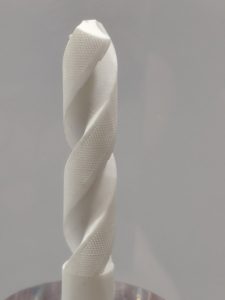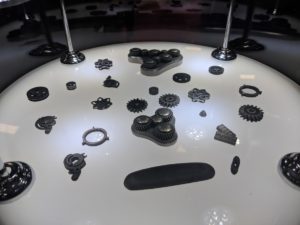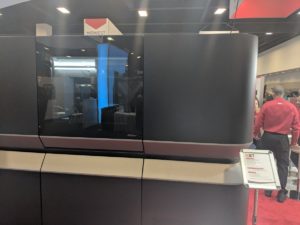 Israel-based XJet has been making headlines for its innovative NanoParticle Jetting 3D printing for years now, as the inkjet technology is applicable for both metal and ceramic manufacture. We’ve been following as the company has shared its progress at major industry shows, and I’ve appreciated the opportunities to talk with company executives at the last two incarnations of formnext in Germany. Last week in Texas, XJet had a slew of exciting announcements to share as NanoParticle Jetting (NPJ) is formally leaving the lab.
Israel-based XJet has been making headlines for its innovative NanoParticle Jetting 3D printing for years now, as the inkjet technology is applicable for both metal and ceramic manufacture. We’ve been following as the company has shared its progress at major industry shows, and I’ve appreciated the opportunities to talk with company executives at the last two incarnations of formnext in Germany. Last week in Texas, XJet had a slew of exciting announcements to share as NanoParticle Jetting (NPJ) is formally leaving the lab.
Beginning with a video highlighting Israeli company Syqe Medical’s use of XJet 3D printing, the company press conference was led by the ever-energetic XJet CBO Dror Danai.
“This day, this month, this event is when we take XJet out, after all the introductions, we are now bringing it out. It took over $100 million to get together more than 100 employees, mainly R&D engineers, for over 10 years to create 80 original XJet patents,” Danai announced.
“NanoParticle Jetting deposits 222 million drops per second, and is unique in three directions: part properties, safe and simple operation, and new geometry standards.”
He broke these aspects down a bit further:
- Part Properties: 100% dense after sintering
- Safe and Simple Operation: Cartridge-only powderless system, can operate safely in an office environment
- New Geometry Standard: Fine detail, thin wall; example of a detailed ceramic drill bit with <100-micron-radius conformal cooling channels
The Carmel system, introduced ahead of formnext 2017, is a 5,000 pound machine designed for safe operation — and that operation is ramping up as it makes its way into the world. With a first global installation late last year and the first system in the US running now at the Youngstown Business Incubator — this latter in fact with an open house highlighting the installation happening tonight — the Carmel additive manufacturing system is just getting started.
Danai noted highlights the company is looking forward to in the next months, including:
- April: Installed three machines. Taking more customers, getting ready to talk to channel partners (“We have had dozens, if not more, applications” from interested channel partners)
- May: Major step forward with tonight’s open house at YBI
- June: Starting to ramp up, start doubling production, and increase capacity to a much larger scale
- July: Opening a 20,000-square-foot additive manufacturing center in Israel with 10 Carmel systems, led by Liat Laufer, XJet AM Center Manager
- August: Moving to a new, larger office
“This is a company that is ready for business,” Danai said in summary of the major busines steps forward.
Following these announcements, I returned to the XJet booth to speak with company CEO and Founder Hanan Gothait to catch up on all that has happened in the few months since our last conversation. The messaging was aligned with the morning’s press conference: XJet is ready for the world.
“We spent years in the lab, and it’s now time — the product is ready to move ahead,” Gothait told me in welcome.
“Probably by the end of this year we will see 20 installations. It is a challenge; we are still small, and growing quickly. Growing is a process, as we are focused on getting the right people.”
The message of growth was a theme throughout our discussion, as XJet seeks to stay true to “the genetics of the company” with a significant focus on quality above all: quality in personnel, quality in product and technology, quality in business strategy. With a company comprised primarily of engineers, the thinking seems to be in the right place for ensuring that each step is a genuine stride forward. For this year, XJet is focusing mainly on ceramics and metals capabilities, and has seen great interest from the industry.
“It’s exciting,” Gothait continued. “We have many customers, many interested in working with us — many more than we can supply.”
That level of interest is certainly indicative of larger trends in the industry as additive manufacturing continues to capture not only interest and attention but actual market share as applications shine.
“The industry is at a unique stage in developing 3D strategies,” he told me. “Customers are approaching us with: this is what we want to do, these actual applications. I think it is new, that many companies know what they want to do. We are creating solutions so we can give them what they want exactly so they can do exactly what they want.”
Here, we came back to the point of quality, which underscores so much for Gothait’s vision for XJet as the company commercializes. Focusing on what’s truly important to the company is a critical part of strategic approach to the market, and for XJet that comes down to the team and the solutions they provide. With actual machine manufacturing done by a subcontractor, scaling on that aspect is “not a big deal” as the company is “in good shape” in that regard; the real drive is for the team to constantly improve total offerings.
“We have a lot of focus on quality of what we do, not on large numbers of printers; it’s quality and support. We want to learn from customers — we always learn and improve, it’s a constant cycle. We listen and really improve on any aspect, printer, material, process, safety, then supply or improve solutions. We invest a lot in our specialty team to improve,” Gothait continued, adding that the company is recruiting now and looking to hire “excellent people who fit the genetics of the company.”
At RAPID + TCT, the XJet booth was regularly busy with visitors. Many attendees coming by, Gothait told me, had heard about the company and were “excited to come see what we do,” while the XJet team were excited to show them the process, technology — including a VR tour inside the Carmel system itself — and capabilities.
The fine detail of the prints at XJet were evidence that NPJ delivers on its promises, which Gothait sees as a “big breakthrough in the industry.” The lack of powders for NPJ offers a new capability, and reduces the need for post-processing and support removal. Gothait noted that NPJ’s capabilities set XJet apart from the more common metal 3D printing technologies, including lasers, powder bed, and binder jet.
Speaking to the next moves for the company, Gothait underscored the importance of the upcoming Additive Manufacturing Center, which represents a $10 million investment. The company, he said, wants “to bring more there,” as Liat Laufer will be managing the center and helping to advance technologies there. Ease of use is a mainstay for XJet; even with its advanced technology, it is important to the company that operation be user friendly.
“We take students, totally untrained, and tell them: go print. A PhD in physics can print, no problem — we want it to be so easy to use that anyone can. Anyone, with a two-day training, can then start using these. We believe this is a big enabler for manufacturing,” he explained.
Touching on customers putting their systems to use, Gothait noted that Syqe Medical creates end-use parts for its unique medical devices, while Russia-based AB Universal (ABU) is also a “very good partner,” creating implants and working on other medical applications. Every few weeks, Gothait said, XJet is bringing on a new customer, and over the next few months we should expect to see many more joining.
“We are spending a lot of time testing, making sure everything works perfectly,” he said. “We see our customers as partners, and work closely with them all.”
As XJet ramps up production of its NanoParticle Jetting systems, we will continue to keep up with the company’s progress outside the lab and in real-world conditions.
Discuss XJet, NanoParticle Jetting, other 3D printing topics at 3DPrintBoard.com or share your thoughts in the Facebook comments below.
[All photos: Sarah Goehrke]
Subscribe to Our Email Newsletter
Stay up-to-date on all the latest news from the 3D printing industry and receive information and offers from third party vendors.
Print Services
Upload your 3D Models and get them printed quickly and efficiently.
You May Also Like
3D Printing News Briefs, July 2, 2025: Copper Alloys, Defense Manufacturing, & More
We’re starting off with metals in today’s 3D Printing News Briefs, as Farsoon has unveiled a large-scale AM solution for copper alloys, and Meltio used its wire-laser metal solution to...
3DPOD 260: John Hart on VulcanForms, MIT, Desktop Metal and More
John Hart is a Professor at MIT; he´s also the director of the Laboratory for Manufacturing and Productivity as well as the director of the Center for Advanced Production Technologies....
3D Printing News Briefs, June 28, 2025: Defense Accelerator, Surgical Models, & More
In this weekend’s 3D Printing News Briefs, 3YOURMIND was selected to join an EU Defense Accelerator, and PTC has announced model-based definition (MBD) capabilities within Onshape. Finally, a study out...
EOS in India: AM’s Rising Star
EOS is doubling down on India. With a growing base of aerospace startups, new government policies, and a massive engineering workforce, India is quickly becoming one of the most important...













































